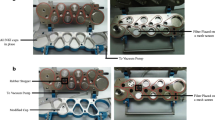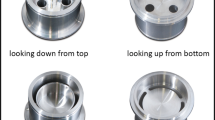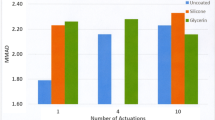Abstract
Abbreviated impactors have been developed recently to allow more rapid evaluation of inhalation products as alternates to the eight-stage Andersen Cascade Impactor (ACI) which has been widely used in the pharmaceutical industry for assessing aerodynamic particle size distribution. In this paper, a two-stage abbreviated impactor, Westech Fine Particle Dose Impactor (WFPD), was used to characterize the aerodynamic particle size of metered dose inhaler (MDI) products, and the results were compared with those obtained using the standard eight-stage ACI. Seven commercial MDI products, with different propellants (chlorofluorocarbon/hydrofluoroalkane) and formulation types (suspension/solution, dry/normal/wet), were tested in this study by both WFPD and ACI. Substantially equivalent measures of fine particle fraction were obtained for most of the tested MDI products, but larger coarse particle fraction and extra-fine particle fraction values were measured from WFPD relative to those measured using the ACI. Use of the WFPD also produced more wall loss than the ACI. Therefore, it is recommended that the system suitability be evaluated on a product-by-product basis to establish substantial equivalency before implementing an abbreviated impactor measurement methodology for routine use in inhaler product characterization.





Similar content being viewed by others
References
US Food and Drug Administration. Draft guidance for industry: metered dose inhaler (MDI) and dry powder inhaler (DPI) drug products. 1998.
European Medicines Agency. Guideline on the pharmaceutical quality of inhalation and nasal products. 2006.
European Pharmacopeia. Section 2.9.18—preparations for inhalation: aerodynamic assessment of fine particles. European Pharmacopeia. 5 ed. 67075 Strasbourg, France: Council of Europe; 2005. p. 2799–811.
United States Pharmacopeia. USP 30-NF 25; chapter 601—physical tests and determinations: aerosols. Rockville, MD, USA: United States Pharmacopeia; 2007. p. 220–40.
Mitchell JP, Nagel MW, Avvakoumova V, MacKay H, Ali R. The abbreviated impactor measurement (AIM) concept: part 1—influence of particle bounce and re-entrainment—evaluation with a “dry” pressurized metered dose inhaler (pMDI)-based formulation. AAPS PharmSciTech. 2009;10(1):243–51.
Mitchell JP, Nagel MW, Avvakoumova V, MacKay H, Ali R. The abbreviated impactor measurement (AIM) concept: part II—influence of evaporation of a volatile component—evaluation with a “droplet-producing” pressurized metered dose inhaler (pMDI)-based formulation containing ethanol as cosolvent. AAPS PharmSciTech. 2009;10(1):252–7.
Mitchell JP, Nagel MW, Doyle CC, Ali RS, Avvakoumova V, Christopher JD, et al. Relative precision of inhaler aerodynamic particle size distribution (APSD) metrics by full resolution and abbreviated Andersen cascade impactors (ACIs): part 1. AAPS PharmSciTech. 2010;11(2):843–51.
Mitchell JP, Nagel MW, Doyle CC, Ali RS, Avvakoumova V, Christopher JD, et al. Relative precision of inhaler aerodynamic particle size distribution (APSD) metrics by full resolution and abbreviated Andersen cascade impactors (ACIs): part 2—investigation of bias in extra-fine mass fraction with AIM-HRT impactor. AAPS PharmSciTech. 2010;11(3):1115–8.
Keegan G, Lewis D. Rapid prototype screening with the Copley Fast Screening Andersen (FSA). In: Dalby R, Byron P, Peart J, Suman J, Young P, editors. Respiratory drug delivery 2012. River Grove: Davis HealthCare Int. Publishing; 2012. p. 469–72.
Keegan G, Lewis D. Formulation-dependent effects on aerodynamic particle size measurements using the Fast Screening Andersen (FSA). In: Dalby R, Byron P, Peart J, Suman J, Young P, editors. Respiratory drug delivery 2012. River Grove: Davis HealthCare Int. Publishing; 2012. p. 465–8.
Chambers F, Smurthwaite M. Comparative performance evaluation of the Westech Fine Particle Dose (FPD) impactor. In: Dalby R, Byron P, Peart J, Suman J, Young P, editors. Respiratory drug delivery 2012. River Grove: Davis HealthCare Int. Publishing; 2012. p. 553–7.
Andersen AA. A sampler for respiratory health assessment. Am Ind Hyg Assoc J. 1966;27(2):160–5.
Berg E, Lamb P, Ali A, Dennis J, Tservistas M, Mitchell J. Assessment of the need to coat particle collection cups of the NGI to mitigate droplet bounce when evaluating nebuliser produced droplets. PharmEuropa Sci Notes. 2008;1:21–6.
Mitchell JP, Nagel MW. Cascade impactors for the size characterization of aerosols from medical inhalers: their uses and limitations. J Aerosol Med. 2003;16:341–77.
Disclaimer
The findings and conclusions in this article have not been formally disseminated by the Food and Drug Administration and should not be construed to represent any agency determination or policy.
Author information
Authors and Affiliations
Corresponding author
Rights and permissions
About this article
Cite this article
Guo, C., Ngo, D., Ahadi, S. et al. Evaluation of an Abbreviated Impactor for Fine Particle Fraction (FPF) Determination of Metered Dose Inhalers (MDI). AAPS PharmSciTech 14, 1004–1011 (2013). https://doi.org/10.1208/s12249-013-9984-7
Received:
Accepted:
Published:
Issue Date:
DOI: https://doi.org/10.1208/s12249-013-9984-7




